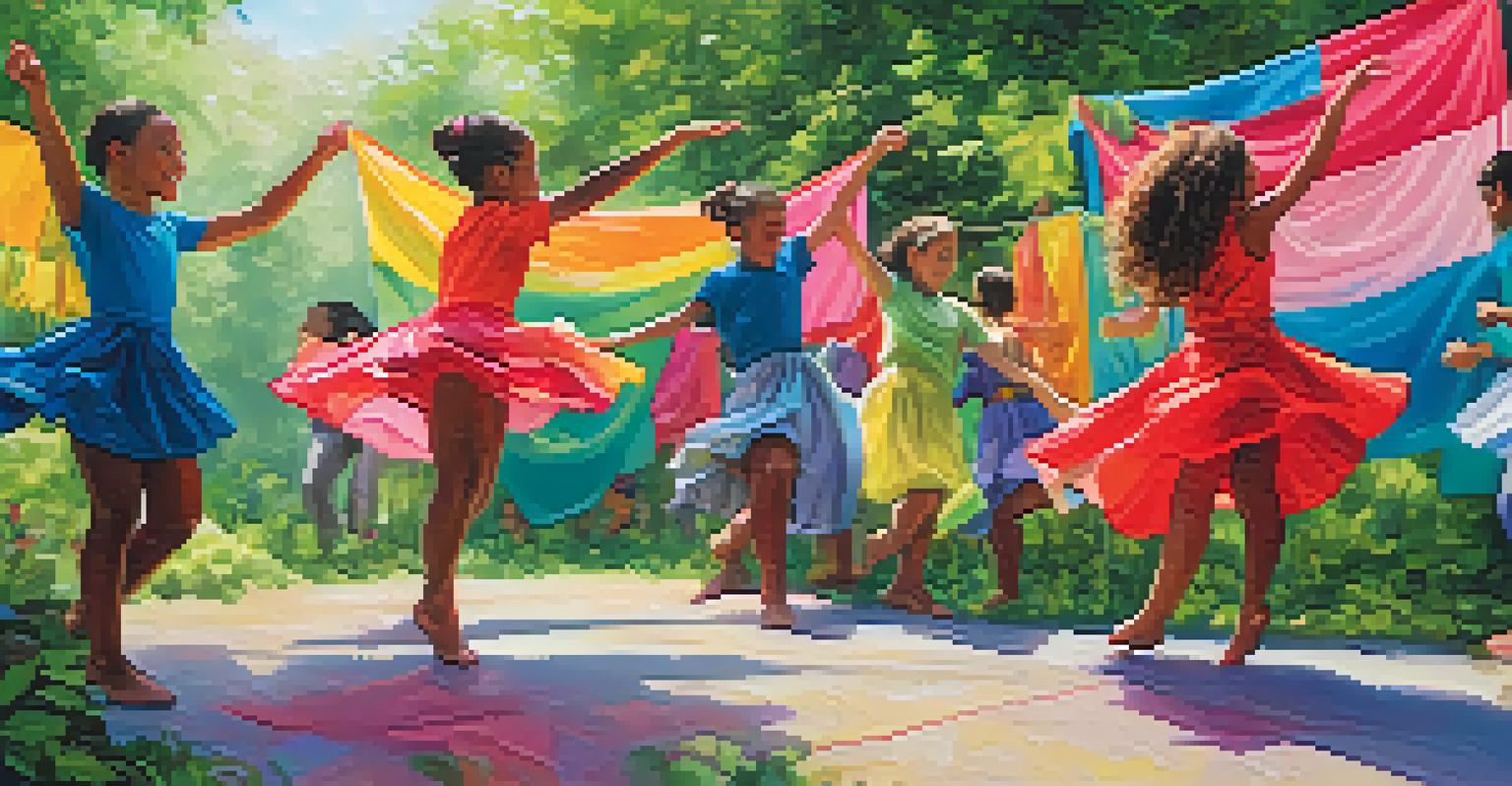Integrating Environmental Themes into Dance Performances

The Role of Dance in Environmental Awareness
Dance has always been a powerful medium for storytelling and expression. By integrating environmental themes, choreographers can raise awareness about pressing ecological issues. Imagine a performance where dancers mimic the fluidity of water, highlighting the importance of conservation and the impact of pollution.
Dance is the hidden language of the soul.
This artistic approach not only captivates audiences but also encourages them to reflect on their relationship with nature. It creates a visceral connection that statistics and speeches often fail to achieve. Through movement, dancers can embody the urgency of climate change and inspire action.
Ultimately, using dance as a platform for environmental advocacy transforms the art form into a vehicle for change. It invites audiences to feel, think, and engage with the world around them, fostering a deeper understanding of environmental concerns.
Choreographic Techniques for Environmental Themes
Choreographers can draw inspiration from nature to create movement that resonates with environmental themes. For instance, the ebb and flow of ocean waves can be mirrored in a contemporary dance piece, symbolizing the delicate balance of marine ecosystems. Using improvisation can also capture the spontaneity of natural elements, making the performance feel alive.

Additionally, incorporating props made from recycled materials can enhance the visual narrative. These elements serve as tangible reminders of the environmental message the performance conveys. By blending movement with innovative design, choreographers can create a holistic experience for the audience.
Dance as Environmental Advocacy
Dance can effectively raise awareness about ecological issues by creating a visceral connection that statistics often can't achieve.
Moreover, engaging dancers in the creative process fosters a deeper connection to the theme. When performers understand the significance of their movements in relation to environmental issues, it adds an authentic layer to the performance that resonates with viewers.
Collaboration with Environmental Organizations
Partnering with environmental organizations can amplify the impact of dance performances. These collaborations can provide valuable insights into current ecological issues, ensuring that the themes explored are relevant and impactful. For example, a dance company might work with a local conservation group to raise awareness about endangered species through a poignant performance.
Art is not a mirror held up to reality, but a hammer with which to shape it.
Such partnerships not only enhance the narrative but also offer opportunities for community engagement. Workshops and discussions can be organized alongside performances, allowing audiences to learn more about the issues presented on stage. This creates a multi-dimensional experience that extends beyond the performance itself.
Additionally, these collaborations can lead to fundraising efforts that support environmental initiatives. By connecting art with activism, dance performances can become a catalyst for positive change in the community.
Incorporating Technology to Enhance Environmental Themes
Technology can play a crucial role in enhancing dance performances focused on environmental themes. Using projections of natural landscapes or environmental statistics can create a striking backdrop that complements the choreography. This visual element can help to immerse the audience in the narrative, making the message more impactful.
Moreover, digital platforms can extend the reach of these performances beyond the theater. Live-streaming dance pieces or creating online content that addresses environmental issues can engage a wider audience. This adaptability allows the conversation around environmental themes to flourish in various formats.
Collaboration Amplifies Impact
Partnering with environmental organizations enhances the relevance of dance performances and fosters community engagement.
Additionally, incorporating soundscapes that mimic natural environments can further enrich the sensory experience. By blending visual and auditory elements, choreographers can create a layered performance that heightens emotional responses and inspires action.
Audience Engagement and Participation
Engaging the audience in the performance can enhance their connection to the environmental themes presented. Interactive elements, such as inviting viewers to join in a simple movement or share their thoughts on sustainability, can foster a sense of community. This participation transforms passive observers into active contributors to the message.
Workshops and post-show discussions provide additional avenues for engagement. These opportunities allow audiences to delve deeper into the themes explored in the performance and discuss actionable steps they can take in their own lives. It creates a dialogue that extends beyond the stage.
Through engagement, audiences are more likely to carry the environmental message with them long after the performance ends. This lasting impact is a testament to the power of dance as a medium for social change.
Case Studies: Successful Environmental Dance Performances
Several dance companies have successfully integrated environmental themes into their performances, demonstrating the power of this approach. For instance, the 'Earth Dance' project brought together dancers from around the world to raise awareness about climate change through a series of performances. Each piece highlighted different aspects of environmental degradation, leaving a profound impact on audiences.
Another notable example is 'The River Project,' which used dance to explore the significance of freshwater ecosystems. By collaborating with scientists and environmentalists, the performance provided an artistic interpretation of the importance of rivers and the threats they face. This blend of art and science created a compelling narrative that resonated with viewers.
Technology Enhances Storytelling
Incorporating technology like projections and soundscapes enriches dance performances, making the environmental message more impactful.
These case studies exemplify how dance can effectively address environmental issues, making the abstract concrete and relatable. They serve as inspiration for other choreographers looking to make a difference through their art.
The Future of Dance and Environmental Advocacy
As awareness of environmental issues continues to grow, the role of dance in advocacy is likely to expand. Choreographers will increasingly explore innovative ways to address climate change, biodiversity loss, and sustainability through their work. This evolution reflects a broader cultural shift towards valuing art as a tool for social change.
Moreover, as technology advances, the potential for integrating digital media into dance performances will open new avenues for storytelling. This can lead to even more immersive experiences that captivate and educate audiences about environmental themes. The future of dance is poised to be more dynamic and interconnected than ever before.

Ultimately, the integration of environmental themes into dance performances represents a powerful convergence of art and activism. By harnessing the expressive potential of dance, artists can inspire audiences to take action and foster a deeper appreciation for the environment.